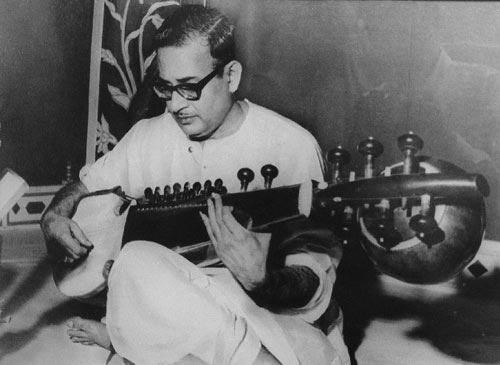Disciples
En juin 2000, lors de notre dernière rencontre avant qu’il quitte l’Europe pour les Etats-Unis, j’avais demandé à Anirban Dasgupta quels étaient (outre son père) « les autres » disciples de Radhu Babu. Voici (dans l’ordre alphabétique) les noms qu’il m’avait donnés :

[extrait de http://www.angelfire.com/ma/sarod/presmsg.html]
Returning to Radhu Babu, his story is a tale of medieval majesty mixed into modern life. His grandfather was a wealthy Zamindar with a huge estate in Rajsahi, then in India, now part of Bangladesh. He was a patron of the arts, especially music, as he himself was a drummer. To enhance his drumming opportunities, he had, living at his court, a man who was arguably the finest sarodist in India, Ustad Mohammed Amir Khan Bangash of Shahjahanpur. Amir Khan’s great grandfather, Gulam Ali Khan Bangash , who was an Afghan rabab player, had invented the sarod by altering a rabab, replacing gut strings with metal and installing a metal fingerboard instead of wood. Gulam Ali’s son, Ustad Murad Ali Khan was the founder of the gharana and his brother Ustad Nanne Khan started another line of the gharana. Nanne Khan’s son was Ustad Hafiz Ali Khan , father of the present day Ustad, Amjad Ali Khan .
Radhu Babu grew up in luxury as a prince and as a young boy he became fond of Amir Khan, the favorite musician at his grandfather’s court. He described to me remembering as a tot, sitting on the shoulders of Amir Khan while the master played sarod. He developed a deep love of sarod and it turned out he had enormous talent. When he reached the age of 11 Amir Khan took him as a serious student. Radhu Babu was not allowed to play rough sports or be away from his guru. Amazingly, he was able to learn the technique and the entire literature of sarod, i.e. all the compositions of the gharana. In 1934 when Radhu Babu was 17 his guru died. At that young age Radhu Babu had become an unbelievable rarity in India, a member of the patronage class who had mastered the art of the musician’s class to perfection. He was known as a prodigy, but he didn’t stop there. He knew that knowledge of classical music was incomplete without a mastery of the gharana descending from Tansen, the court musician of Akbar the Great. For the next 16 years Radhu Babu studied with Ustad Dabir Khan , a direct descendant of Tansen. Dabir Khan had no heir and many musicians of Radhu Babu’s generation learned the Senia line from him. Radhu Babu told me Dabir Khan was a man with no vices!
Partition was a terrible blow to the Maitra family. They were Hindu rulers but the estate was in Muslim East Pakistan. Their lands were lost and the family moved to Calcutta. Until now, music had been the hobby of a gifted prince. In Calcutta it would become his profession. With partition much patronage had dried up. The musicians needed to try to develope other means of support. Public concerts in front of general audiences was the next step. Radhu Babu, along with Jnan Babu, sitarist Mustaq Ali Khan , and musicologist D. T. Joshi were the forces behind a yearly series of public concerts called Jhankar . The programs lasted several days and included many of the greatest masters of the era. Incidentally, Buddhadev Das Gupta told me the first Jhankar concert was at his father’s house and the players were Vilayat Khan , sitar, with Jnan Babu on tabla. Radhu Babu’s sarod playing was matchless, but as a pedagogue he really excelled. He taught individually, not classes. Along the way he developed a system for teaching ragas that reduced the difficulty of learning sufficiently that even a klutz like me could pick it up. Of course many of his students, far from being klutzes, are highly gifted artists. Buddhadev Das Gupta has elevated sarod playing to a level previously unknown. Sanjoy Bandopadhyaya is a master sitarist and professor of sitat a the Indira Kala Sangeet University, Khairagarh. Also at Khairagarh is Professor Joydeep Ghosh, sarodist. Other outstanding disciples include Kalyan Mukherjea, who was also a professor of mathematics at UCLA, Sandhya Ghosh, who was chancellor of the medical university in Calcutta, Himadri Bagchi, sitarist, Sugato Nag, sitarist, and many others I am unforgiveably omitting.
It is all of us and our students who now represent the Seniya-Shahjahanpur gharana of Murad Ali Khan. Md. Amir Khan had no heir, Radhu Babu had no heir: the gharana must be carried forward by disiples rather than family. It means that if we do not perform and teach to others the great compositions of our gharana they will totally die out. The compositions are not written down and are not in the library. They are living and breathing only if we make it so. The goal of the Sarodya Society is the continuing life of the old masterpieces as well as creating the environment necessary for the creation of new masterpieces.